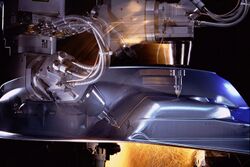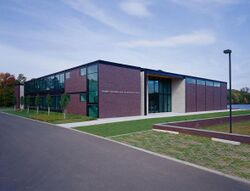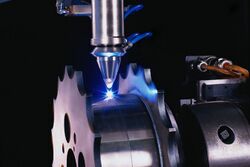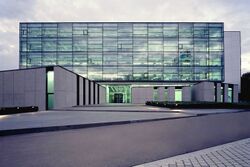Trumpf
Topic: Company
 From HandWiki - Reading time: 4 min
From HandWiki - Reading time: 4 min
 | |
| Type | GmbH + Co. KG |
|---|---|
| Industry | mechanical engineering |
| Founded | 1923 |
| Headquarters | Ditzingen, Germany |
Key people | Nicola Leibinger-Kammüller, President and Chairwoman of the Managing Board, Peter Leibinger, Vice Chairman of the Managing Board, Mathias Kammüller, Lars Grünert, Heinz-Jürgen Prokop, Christian Schmitz |
| Revenue | |
Number of employees | |
| Website | trumpf.com |
The TRUMPF Group is a German family-owned company with its head office in Ditzingen near Stuttgart.[1] TRUMPF is one of the world's biggest providers of machine tools. With more than 70 operative subsidiaries, the TRUMPF Group is represented in all important markets worldwide. Its production facilities are based in China, Germany, France, the UK, Italy, Japan, Mexico, Austria, Poland, Switzerland, the Czech Republic and the US.[2]
Divisions
The two divisions Machine Tools and Laser Technology are under the umbrella of a holding company, TRUMPF GmbH + Co. KG.[3] In the past they sold their Medical Technology division. This sector is now a part of the Hill-Rom Holdings.[4]
Machine Tools
The larger area of activity comprises machine tools for flexible sheet metal and tube processing. Trumpf offers machines for bending, punching, combined punch and laser processing, and also laser cutting and welding applications. Diverse automation solutions and a range of software for digitally connected production solutions round off the portfolio.[5]
Laser Technology
The product range in laser technology comprises laser systems for the cutting, welding and surface treatment of three-dimensional components. Trumpf also provides high-performance CO2 lasers, disk and fiber lasers,[6][7] direct diode lasers,[8] ultrashort pulse lasers,[9] and also marking lasers and marking systems.[10] 3D printing machines for metal components were added to the portfolio in 2015.[11]
Company history
Beginnings
In 1923, Christian Trumpf and two partners acquired Julius Geiger GmbH, a machine shop in Stuttgart. The company manufactured flexible shafts used in metal processing machines, amongst other applications, and motor-driven hand shears for cutting sheet metal. In 1933, the company moved to the Stuttgart suburb of Weilimdorf. During World War II, TRUMPF continued with the production of electric shears and flexible shafts. The production buildings remained undamaged.[12]
The economic miracle years
During the post-war years, stationary machines for sheet metal processing were a main constituent of the product program. In 1950, TRUMPF employed 145 people, and its sales exceeded the one-million mark.Ten years later, these figures had increased to 325 employees and sales of DM 11 million. In 1963, the company founded its first foreign company at the Swiss town of Baar in the Canton of Zug.
World market
In 1968, TRUMPF manufactured the TRUMATIC 20, the first sheet metal fabrication machine with a numerical control system. It enabled fully automatic work at the machine, right down to tool changes, for the very first time. All the information required to process sheet metal was stored on perforated computer tape.
One year later, the company founded a U.S. subsidiary in Farmington, Connecticut. Farmington is now the company's second-largest location and is the headquarters for the entire U.S. market. In 1972, TRUMPF shifted its headquarters to Ditzingen. In 1978, Berthold Leibinger was appointed chairman of the Managing Board, and founded a subsidiary in Japan in the same year.
Laser
In 1985, TRUMPF presented its own CO2 laser, the LASER TLF 1000. It had 1 kW of beam performance and is the first compact laser resonator with radio-frequency excitation. In 1988, TRUMPF Lasertechnik GmbH was founded.
In 1992, the solid-state laser sector began with its participation in the firm of Haas Laser GmbH in Schramberg. The company is now 100-percent owned by the TRUMPF Group. On November 20, 1998, a new laser factory was opened at the company's headquarters in Ditzingen.[12]
New business activities
In the 1990s, Trumpf complemented its portfolio by integrating new methods of sheet metal processing like bending (1992) and tube processing (1999).[13] Completely new fields like medical technology were tapped as well. This was, however, sold again to Hillrom in 2013.[14]
Change of generation
In 2005, shortly before his 75th birthday, Berthold Leibinger retired from the Managing Board after 40 years. His daughter Nicola Leibinger-Kammüller was appointed as the new President and Chairwoman of the Managing Board. As well as her brother Peter Leibinger, the Vice-Chairman of the Managing Board, her husband Mathias Kammüller also has a seat on the Managing Board.[15]
Smart Factory
In September 2017 the company has opened a new technology center in Chicago, IL for Industry 4.0 solutions that is designed for digitally connected production processes.[16]
Key figures of the TRUMPF Group
| Business year | Sales | Employees |
|---|---|---|
| 2017/18 | 3.57 bn euros | 13,420 employees |
| 2016/17 | 3.11 bn euros | 11,883 employees |
| 2015/16 | 2.81 bn euros | 11,181 employees |
| 2014/15 | 2.71 bn euros | 10,873 employees |
| 2013/14 | 2.59 bn euros | 10,914 employees, including 5,599 in Germany |
| 2012/13 | 2.34 bn euros | 9,925 employees, including 5,348 in Germany |
| 2011/12 | 2.33 bn euros | 9,555 employees, including 5,207 in Germany |
| 2010/11 | 2.03 bn euros | 8,550 employees, including 4,675 in Germany |
| 2008/09 | 1.34 bn euros | approx. 8,000 employees, including about 4,550 in Germany |
| 2007/08 | 2.14 bn euros | approx. 8,000 employees, including about 4,550 in Germany |
| 2006/07 | 1.94 bn euros | approx. 7,250 employees, including about 4,280 in Germany |
| 2005/06 | 1.65 bn euros | approx. 6,500 employees, including about 4,000 in Germany |
| 2004/05 | 1.4 bn euros | approx. 6,100 employees, including about 3,800 in Germany |
| 2003/04 | 1.22 bn euros | employees: 5,790 |
References
- ↑ "A Happy Family of 8,000, but for How Long?". New York Times. https://www.nytimes.com/2009/07/12/business/global/12german.html. Retrieved 11 July 2009.
- ↑ "Home - TRUMPF Group". trumpf.com. http://www.trumpf.com/en.html.
- ↑ "Annual report" (in en). https://www.trumpf.com/en_INT/company/trumpf-group/annual-report/?LS=1.
- ↑ Hill-Rom Holdings, Inc. (16 June 2014). "Hill-Rom Announces Definitive Agreement To Acquire TRUMPF Medical". prnewswire.com. http://www.prnewswire.com/news-releases/hill-rom-announces-definitive-agreement-to-acquire-trumpf-medical-263259511.html.
- ↑ "Machines & systems" (in en). https://www.trumpf.com/en_INT/products/machines-systems/.
- ↑ "CO2 lasers" (in en). https://www.trumpf.com/en_INT/products/lasers/co2-lasers/.
- ↑ "Disk lasers" (in en). https://www.trumpf.com/en_INT/products/lasers/disk-lasers/.
- ↑ "Diode lasers" (in en). https://www.trumpf.com/en_INT/products/lasers/diode-lasers/.
- ↑ "Short and ultrashort pulse laser" (in en). https://www.trumpf.com/en_INT/products/lasers/short-and-ultrashort-pulse-laser/.
- ↑ "Marking lasers" (in en). https://www.trumpf.com/en_INT/products/lasers/marking-lasers/.
- ↑ "3D printing systems" (in en). https://www.trumpf.com/en_INT/products/machines-systems/3d-printing-systems/.
- ↑ 12.0 12.1 "Milestones of History - TRUMPF Group". trumpf.com. http://www.trumpf.com/en/company/history.html.
- ↑ "1996-2004" (in en). https://www.trumpf.com/en_INT/company/trumpf-group/milestones-in-the-history-of-trumpf/1996-2004/.
- ↑ "Hill-Rom Announces Definitive Agreement To Acquire TRUMPF Medical (NYSE:HRC)" (in en). http://ir.hill-rom.com/releasedetail.cfm?ReleaseID=854715.
- ↑ "Dr. phil. Nicola Leibinger-Kammüller". trumpf.com. http://www.trumpf.com/en/company/managing-board/nicola-leibinger-kammueller.html.
- ↑ "TRUMPF opens smart factory in Chicago". http://www.industrial-lasers.com/articles/2017/09/trumpf-opens-smart-factory-in-chicago.html.
- ↑ "Facts and Figures". trumpf.com. http://www.trumpf.com/en/company/facts-and-figures.html.
External links
 KSF
KSF





